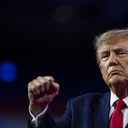Trump calls for more tariffs on China

Former President Trump escalated his attacks on China at CPAC last night, testing his ability to move the U.S. toward a more confrontational approach on trade with the communist nation.
Why it matters: The last six years have shown that Trump’s hawkish proposals on China — initially dismissed as dangerous and impossible — have a way of becoming plausible, and even policy.
Driving the news: Last night's speech was the live version of a campaign video Trump released last week, in which he essentially called for the decoupling of the U.S. and Chinese economies.
- On Capitol Hill, his latest calls didn't spark outrage, as they did in 2016. Democrats and Republicans agree the U.S. needs to rely less on China.
- Committees for both the House and Senate have held hearings this session that focused on various threats China poses to the U.S.
- As president, Trump imposed a series of tariffs on China — and President Biden has kept them on the books.
What they're saying: “The American people have the habit of moving from indifference to outrage in very short order,” Sen. Todd Young (R-Ind.) told Axios. “And that's happened as it pertains to China.”
- “Trump did shift the conversation” on China policy, Sen. Joni Ernst (R-Iowa) told Axios. “He will continue to shift [it]. We need to find ways to decouple when it comes to anything regarding national security.”
- Sen. Robert Menendez (D-N.J.), chair of the Senate Foreign Relations Committee, agreed that the U.S. approach to China has changed significantly in recent years.
- “I think the movement is relatively nascent,” he told Axios.
- “There's a lot more to be done on the China list," he said, citing everything from China's "digital authoritarianism" to "concentration camps" in Xinjiang as areas that need urgent attention.
Flashback: In 2016, Trump’s pledge to impose 45% tariffs on most exports from China was decried by economists as a recipe for a recession, and pilloried by his political opponents.
- Ultimately, Trump settled on a 25% rate, and China responded by hitting America's agricultural exports.
- A study from the pro-trade US-China Business Council estimated that as many as 245,000 U.S. jobs were lost as a result of Trump's tariffs.
- While president in 2019, Trump announced a "phase 1" trade deal with China, which required Beijing to buy some $200 billion in U.S. goods — but Beijing didn't completely follow through.
The big picture: Trump seeks to return to the White House by running against two adversaries: Biden and China.
- With Biden having accepted Trump’s tariffs, the former president is trying to differentiate himself — and ride the current wave of concern about the threats China poses to the U.S.
- Trump's latest anti-China proposals — promising universal baseline tariffs, phasing out all Chinese imports of essential goods in four years and stripping China of its most favored nations status — are an escalation from his 2016 positions.
The other side: Biden also has read the country’s anti-China mood and has adopted a more confrontational approach.
Last October, he imposed export restrictions on semiconductor technology and is considering new rules on outbound investment to China.
What we’re watching: Trump stopped short of calling for a total decoupling of the two economies.
- His proposal sounds more like the “strategic decoupling” that his former trade ambassador, Robert Lighthizer, outlined in a December New York Times op-ed.
Between the lines: Some Republicans from farm states have tempered their enthusiasm for aggressively confronting China with concerns that any retaliation could devastate their home-state agricultural industries.
- To help farmers survive during the first phase of his trade war, Trump gave them an extra $28 billion, a hint of the kind of losses they could suffer if Trump — or Biden — were to pile on more tariffs.
- “In Iowa, farmers rely on exports, and we want to continue to see those exports,” Ernst said. “So there's a balance to be had there.”
The bottom line: Positions that once were unthinkable — such as imposing 25% tariffs on America’s third biggest trading partner — are now consensus views.
- The question now is how much more change the alarm over China will inspire.
- “President Trump is solely responsible for reorienting the Republican Party to understand and address the China threat,” Rep. Jim Banks (R-Ind.) told Axios. “Now the Republican Party is still there, with him out of power.”